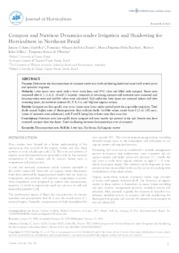Compost and nutrient dynamics under irrigation and shadowing for horticulture in Northeast Brazil.
Compost and nutrient dynamics under irrigation and shadowing for horticulture in Northeast Brazil.
Author(s): GADELHA, J. C.; XAVIER, F. A. da S.; ESCOBAR, M. E. O.; GILKES, R. J.; OLIVEIRA, T. S. de
Summary: Purpose: Determine the decomposition of compost under two levels of shading (total and none) and central pivot and sprinkler irrigation. Methods: Litter boxes were made with a 4mm mesh base, and PVC sides and filled with compost. Boxes were recovered after 0, 2, 4, 6, 8, 10 and 12 months. Amounts of remaining compost and nutrients were measured and decomposition rates and half-life values were calculated. Soil under the litter boxes was analyzed before and after removing boxes, for nutrient contents (N, P, K, Ca, and Mg) and organic carbon. Results: Compost was lost quickly over time. Losses were faster under central pivot than sprinkler irrigation. Total shade caused higher rates of decomposition than without shade. Half-life values varied from 0.12 to 1.02 years. Losses of nutrients were substantial, with P and K being lost at faster rates than mass loss. Conclusions: Nutrients were lost rapidly from compost and were mostly not present in the soil. Insects may have removed compost from the boxes. Total shadowing increases decomposition rates of compost.
Publication year: 2019
Types of publication: Journal article
Unit: Embrapa Cassava & Fruits
Keywords: Horticultura, Irrigação
Observation
Some of Embrapa's publications are published as ePub files. To read them, use or download one of the following free software options to your computer or mobile device. Android: Google Play Books; IOS: iBooks; Windows and Linux: Calibre.
Access other publications
Access the Agricultural Research Database (BDPA) to consult Embrapa's full library collection and records.
Visit Embrapa Bookstore to purchase books and other publications sold by Embrapa.

